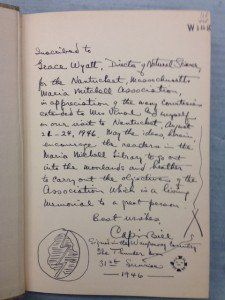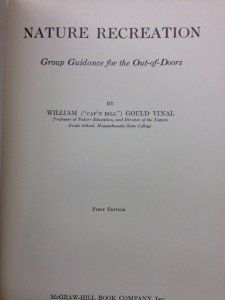More from the Special Collections: William (Cap’n Bill) Gould Vinal
Again, you might not think there is much “exciting” to the book until you crack it open! Never judge a book by its cover they say and here is another example of that. This was an inscription written by Cap’n Bill (William Gould Vinal) in his book Nature Recreation in 1946 for the MMA. He gave the book to the MMA Library that summer when he came to give a lecture for the MMA. His lecture “Natural History of the Pilgrims” was given while he was Director of Nature Education at Massachusetts State College (UMASS). He also gave the last two nature walks of the summer season for the MMA. The book is inscribed in part to Grace Wyatt who was the Director of the Natural Science Department for many years.
Cap’n Bill, as he was known, (1881- 1973) was the author of many books, this one featured here among them. Born in 1881, in Norwell, Mass (then called South Scituate), he graduated from the Bridgewater State Teachers College and then from Lawrence Scientific School at Harvard where he received a second bachelor’s degree and a master’s degree. Later, he received a doctorate from Brown. He became one of the first formal nature educators in the United States. He taught at several universities, taught summer nature camps, served as a ranger naturalist in parks, and then went on to introduce nature education at Western Reserve University in the School of Education. In 1937, he returned to Massachusetts and established the Nature Guide School at the Massachusetts State College (UMASS) from which he retired in 1951. This made him the first instructor in nature education at UMASS. His passion was nature, its conservation, camping, nature guiding, and enjoying and teaching others about the outdoors and nature – a perfect fit for the MMA! Among other things he was a biologist for the Massachusetts Fish and Game Commission, active in Massachusetts Audubon, and he was a prolific writer authoring not only nature books, but nature guides, nature pamphlets, and a nature newsletter that ran for about two decades. There is at least one school named for him in Massachusetts – as well there should be! His papers, in part, can be found at the UMASS libraries. An interesting man and I am glad to learn a bit about him.
JNLF
Recent Posts






